Desert Punk: Volume 2
Introduction
Post-apocalyptic wastelands are a penny a dozen in fiction, and the one in Desert Punk is truly a classic of the genre. A devastating war has wiped out most of civilisation, and the dregs and descendants of the survivors now eke out a living in an endless desert where Japan used to be. People being people, many of them survive by preying on the weak, and this is truly a society where might is right. You'd expect there to be a champion standing up for the weak and oppressed, someone still possessing a moral backbone and a sense of justice. You'd be wrong. There is however the Desert Punk, a.k.a. Sunabozu a.k.a. Kanta Mizuno. He's a cold hard mercenary character who is in it solely for the cold hard cash. Diminutive in stature, and masked behind a hi-tech helmet, he's fast, wily and is just as likely to outwit his opponents, as he is to outfight them. He's developed quite a reputation in the Great Kanto Desert, but he has one, or rather two distinct weaknesses. Breasts! He can't get enough of them. And when one day he encounters Junko Asagiri, a rival mercenary with an exquisite cleavage, he's truly met his match. The next four episodes of Desert Punk are presented here on this disc from MVM, along with more than a handful of extra features.
5. Well and Trap
6. Rockets and Wandering
This first two-part story takes its inspiration from The Magnificent Seven/Seven Samurai, although it can be better labelled as the Lascivious One. The West Oasis District Frontier Village #21 is an industrious settlement, where people work hard to mine water from the ground, hoping to hit a water vein and strike it rich. But when one of the miners overhears the Edogawa gang planning to take advantage of the eventual riches, alarm bells start ringing. Village #21 needs a protector, someone brave and strong and willing to protect the village right now, in exchange for potential riches in the future. What they get is the Desert Punk, who has hit easy street when he enters the village. Soon Sunabozu is taking advantage of the town's food and water rations, as well as the female population, while the miners toil in debilitating heat. Before he outstays his welcome, the Edogawa gang return and in overwhelming force. It looks as if the chips are down, but when the head of the Youth Brigade, and daughter of the village chief Mariko Marimo offers herself up on a plate, that's just the motivation Desert Punk needs. But he hasn't counted on the ingratitude of the greedy miners.
7. Master and Pupil
Sunabozu has an apprentice. Not that he wants one, but Taiko Koizumi, the girl who was helping the sniper three episodes ago, had decided that as victor of that confrontation, Desert Punk now has the privilege of teaching her everything he knows. He's not too keen on hanging around a flat-chested brat, but when she shows him a picture of her well-endowed mother, he formulates a plan, one that involves waiting for DNA to take effect. While he waits, he would be daft not to take advantage of an assistant, and the team of Sunabozu and Kosuna (Little Desert Punk) is born. It's just that Kosuna is missing a little something, talent.
8. Dog-Girl and Rock
After Desert Punk's humiliating experience at the water mine, his reputation as the Kanto Desert's most lethal handyman is in tatters, and his new apprentice hasn't helped matters. He needs a job to put him back on the map. That opportunity arises when a businessman wants a rock cleared from his land. It's not just any rock. The Dog-Girl Rock is an ancient, mythical rock that has stood at the same spot for thousands of years. Anyone who tries to move it is cursed, and given the list of people who have tried and failed, most handymen have been choosing the better part of valour rather than go near the thing. If Sunabozu can shift it, he'll be back at the top of the heap.
Picture
This was one of Gonzo's last 4:3 anime, and naturally the transfer reflects that. Once again, I find my perennial gripe with Gonzo DVDs, that odd combination of compression artefacts and vertical banding, although in this case it is really most obvious only during the live action opening sequence. Otherwise it is a clear and sharp transfer with little to complain about.
The animation is dynamic and vibrant; there is a singular style to the character designs that emphasises bold lines, and high contrast, while the desert setting quite understandably invokes a limited sandy palette of colours, as well as lots of sere, parched landscapes. This is a show where darkness and light play a big part in setting the atmosphere, and it works brilliantly in establishing the mood of the show.
Sound
You have a choice between DD 5.1 English, and DD 2.0 Japanese, along with translated subtitles and an optional signs track. I watched it through in Japanese first and found it to be a wholly enjoyable experience, the stereo doing a good job of conveying the action scenes, the incidental music for once preferable to the theme tunes, and the dialogue clear throughout. However, in a rare reversal, I find Desert Punk's English dub to be superior to the original Japanese soundtrack, and not just because of the added immersion of the 5.1 Surround. For once, an inveterate sub fiend prefers an English dub. It all boils down to masks. A desert environment means that the characters are more often than not masked or shrouded. You can't see their lips move, so dubbing becomes a whole lot easier as there are no lip flaps to match. Desert Punk's dub is nowhere near as constrained as other anime dubs get. It's a lot more freewheeling, ad-libbed, faster, wittier and funnier. It lacks the awkwardness required to fit English dialogue to Japanese phrasing. It takes an occasional liberty with the translation, but it's all the better for it. I must admit though, that re-recording the theme songs with English lyrics is never advisable.
Extras
There are fewer extras than last time, although still more than the average anime disc.
Scenes From The Studios lasts 11 minutes, and takes us into an Internet Radio station. A lot of anime shows have radio shows associated with them, where fans can tune in and listen to skits and sketches, interviews with the cast and more. This shows us what goes on in the studio during a Desert Punk radio broadcast, and it sees voice actors Chihiro Suzuki (Kanta) and Chiwa Saito (Kosuna) hard at play.
The Desert Punk Campaign Caravan in on the move for 9 minutes, as Desert Punk, and model Mari (posing as Junko Asagiri) visit various locales to promote the new anime show. Since Mari is dressed in a rather fetching bikini, the camera linger most on her, and who can blame the cameraman? What was the point to this featurette again?
There are the textless credit sequences of course, and the whole thing is rounded off with trailers for Starship Operators and The Adolescence Of Utena Movie.
Conclusion
When a new anime series starts, it helps sometimes if it generates a buzz, a momentum with its first few episodes, especially if it's a show more suited to style over substance. It's like an intense sugar rush, a quick addictive hit of action, stylish imagery, and individuality that has you coming back for more. The aim of course is to keep that momentum going over the subsequent volumes, and it's something that Gonzo are supremely skilled at. However, Desert Punk's second volume almost lost that buzz completely with its first half, and for a brief 45-minute interlude, I was wondering why it was that I was so eager to experience this series. Fortunately the final half of the disc reminded me, but it was a close thing.
It's the first two-part story that is the problem. The Seven Samurai trope has been done to death in media, and unless it offers something new, something different, then it is never going to feel more than hackneyed, trite and redundant. That's the case here, where the only real difference in Desert Punk's application is that the protector is just as exploitative as the bandits he's supposed to fight. The biggest problem is that at a point where the show should still be building on the premise and developing the characters, this story adds nothing to the pot. It's really just a reiteration of the main character's mission statement, that he's mercenary, greedy, and obsessed with breasts. There's no Junko Asagiri on this disc, which is a shame, but she really could have been of use in the two-parter, as the female interest in this, while as impressive as you would expect in physical stature, is pretty dull and lifeless in terms of character. There's no antagonistic chemistry with Desert Punk, just an initial repugnance that turns to mild affection as the story progresses. Most of all, the humour feels off the boil in this half, it's as if the show is just coasting, not making an effort, and most of the jokes really just miss, the slapstick falls flat, the dark humour isn't dark enough, and Desert Punk's post modern misogyny feels old-fashioned and sad. I was hard pressed to smirk at this point. But this half does set up one essential plot point, that Desert Punk's reputation takes a battering.
It's something that needs to be addressed in the second half of the disc, as he clambers his way back up the Handyman heap, despite the ridicule and abuse from his peers. It's also where the formula does get shook up a bit, with Desert Punk taking on an apprentice. Kosuna was introduced at the end of the first volume, a rather single-minded little girl who was intent on riding the coattails of others to success. She was helping the sniper who had targeted Desert Punk, and when he was defeated, she turned her attentions to Sunabozu as her next Sensei. It's a nice comic set-up to have the supremely confident and skilled Desert Punk paired with a somewhat clumsy and incompetent apprentice who is apt to fall flat on her face. At the same time, Kosuna is wily enough to manipulate Desert Punk, using his perverted nature against him, and to potentially give him a kicking when he gets too lascivious. This is probably the funniest episode of the series so far, especially as Desert Punk has lost his stature as top dog, and is on the receiving end of some choice jeers and jibes. The momentum from this episode continues to the final on the disc, which is an unexpected piece of comic absurdity. The idea of a cursed object is nothing new, and the rock that needs to be removed is certainly profligate with the bad luck towards anyone who even contemplates moving it. The punchline of the show stems from the name of the rock though, and it manifests in the imagination of Sunabozu, with the battle to move the rock, the ultimate in lecherous mind over matter.
Desert Punk Volume 2 is a disc of two halves, with a rather worryingly early dip in quality countered by a hilarious return to form for the final two episodes. Hopefully that early blip is just that, a blip. If the first volume has ensnared you, then there's no reason not to get this second one. But I really need Junko Asagiri to return for volume 3, four episodes without her pneumatic assets is three episodes too long.
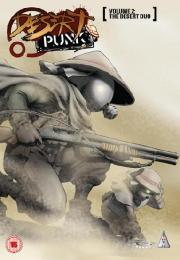

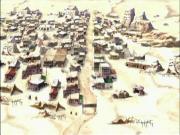
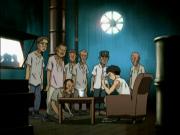

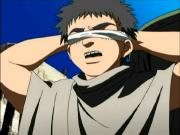
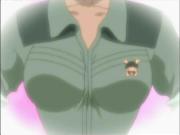
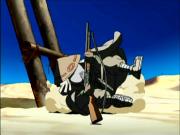
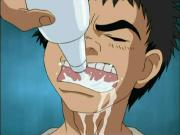
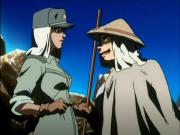

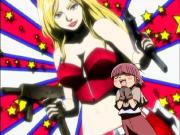
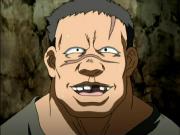
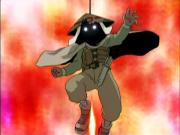
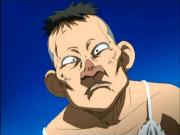
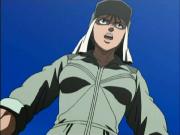
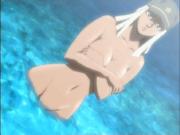

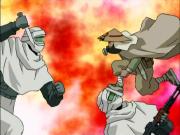

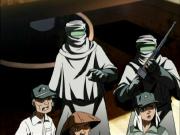
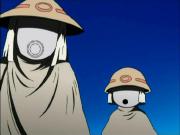


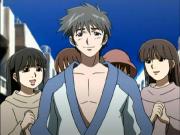
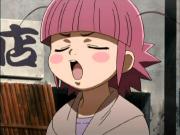
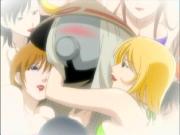
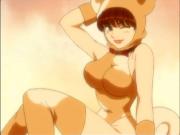
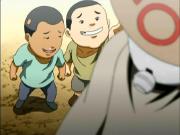
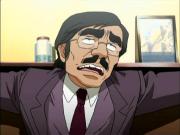
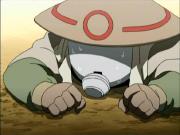



































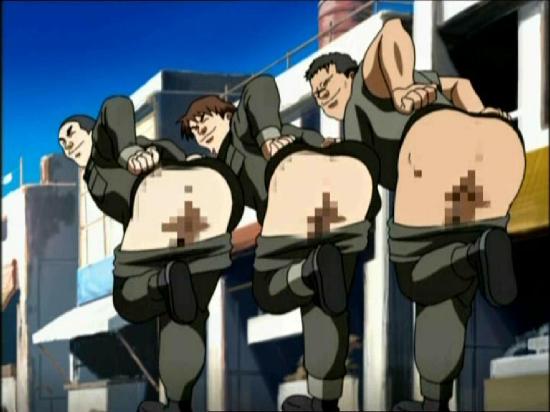




Your Opinions and Comments
Be the first to post a comment!